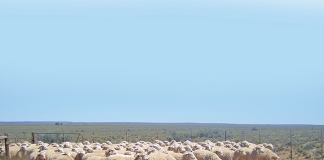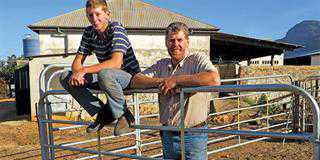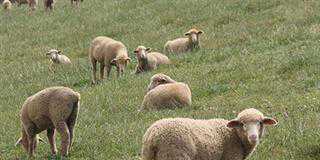It was in 2006, the driest year Australian sheep farmers have ever experienced, that the SA Dohne Merino came into its own, delivering excellent lamb crops and wool clips. Former South African Dohne Merino breed director Cameron McMaster gives a first-hand account of the phenomenal success of this South African breed in Australia.
I have just returned from Australia where I assisted the A ustralian Dohne Breeders’ Association to run workshops for their members. This is the sixth year that I have travelled to Australia to assist with breeder education and promotion and over this period I have seen the Dohne make dramatic inroads in the Australian Merino industry. The first Dohne embryos from South Africa arrived in Australia in 1998. Since then, rising meat prices and an escalating demand for prime lamb exports have seen numbers of the dual-purpose Dohne skyrocket. Dohnes offer woolgrowers the option to improve the meat of their Merinos and exploit the growing prime lamb market without resorting to the traditional terminal meat sire crossbreeding programme, which is depleting the country of its Merino ewe base.
It is estimated that more than 50% of Merino ewes in Australia are currently being mated with mutton breed rams, which has brought the Merino flock to the threshold of unsustainability. The true high-earning potential of the Dohne as a self-replacing, dual-purpose animal, capable of producing high-value prime lamb and quality Merino wool, is now fully recognised. Figure 1 shows the dramatic growth in the number of registered purebred D ohnes in Australia. A total of 42 786 D ohnes were registered up to September 2006. Initially numbers were increased mainly by assisted reproduction techniques such as embryo transfers, but now that numbers have reached a viable level, most studs have resorted to artificial insemination, natural mating and rearing.
Dohnes have continued to perform impressively for commercial growers, with an excellent and growing demand for rams. Dohnes were the third highest number of rams of any breed sold at a public auction in New South Wales (NS W) in 2006, and also achieved the second highest average price. No less than 34 public auctions of Dohnes will be held throughout Australia this year. In famous studs such as Uardry, sales of Dohne rams now exceed those of Merino rams. Uardry will offer some 900 Dohne rams this year on sales at venues throughout Australia.
High fertility and survival rates
While 2005 was very dry, 2006 will be remembered as the driest year Australian sheep breeders have ever experienced. In the past 12 months the Australian sheep population has declined from 96 million to 91 million. It was in these severe circumstances that the hardy Dohnes really held their own, not only surviving well, but delivering excellent lamb crops and wool clips. Wherever I went in Australia, breeders expressed amazement at the performance and survivability of their Dohnes and Dohne crosses. I spent some time in southern NS W, Eastern Victoria and South Australia, where the drought was at its worst, and was shocked to see how bare and dusty the paddocks were – not a blade of forage anywhere and almost all sheep being trailfed on grain. Yet even under these trying conditions Dohne cross lambs twice topped the Dubbo lamb market and breeders sold Dohne lambs for up to 1 (R650) per head. Most studs now have sufficient numbers to practise natural mating, and breeders have been impressed by the inherent fertility of the Dohne. For instance, while I was there, Uardry scanned 900 F2 ewe hoggets mated at 10 months and achieved a 96% conception rate, while in Western Australia the Far Valley Dohne Stud scanned 175% lambs in 400 Dohne Stud ewes naturally mated six weeks earlier.
Ongoing breed improvements
Since the first lamb dropped in 1998, all Dohnes in Australia have been pedigreeand performance-recorded on a national database run by the NS W Primary Industries Department. The selection index incorporates body weight, fleece weight, fibre diameter, coefficient of variation percentage (CV%) of fibre diameter, muscle and fat depth. The latter two records are now mandatory for all Dohnes and are aimed at providing estimated breeding values (EBVs) to improve carcass quality. The progress in the genetic productivity potential is reflected in the improvement of the average index from 1999 to 2005. Figures 1 and 2 illustrate how successful breeders have been at increasing Dohne numbers and genetic progress despite the last two years of drought. Table 1 shows how the traits involved in meat production (body weight and muscle depth) have improved, while the traits influencing wool quality (FD and CV%) have also improved substantially. This year records of 120 000 South African Dohnes were added to the Australian database to enhance the calculation of breeding values of sheep descended from South African embryos.
Recently the Australian Wool Exchange (AWEX) introduced a new national Wool Classers’ Code of Practice, which requires wool shorn from Dohne and SA Mutton Merino sheep to carry the words DOHNE and SAMM stencilled on the bales. While Dohne wool is listed together with other Merino wool in the lowest-risk category for dark and medullated fibre, it is unclear why AWEX felt it necessary to take this step. Evidence emerging from wool tests and sale results indicates that Merino wool from Dohnes is identical to average Merino lots and often superior in terms of FD , CV% and the comfort factor (CF). Tests on large lots of Dohne wool indicate that, in terms of dark and medullated fibre, it is comparable to the very best Merino wool available in the industry. However, the Australian Dohne Breeders’ Association has accepted this ruling as a positive marketing tool. They have launched a campaign to promote the breed by testing all Dohne sale lots for dark fibre and medullation, and compiling a database of average FD , CV and CF. The evidence that emerged confirms that the Dohne ranks amongst the most efficient and productive sheep breeds in the world, unique in its ability to produce both prime lamb and elite fine wool – an achievement South Africa can be very proud of. Contact Cameron McMaster at [email protected].













